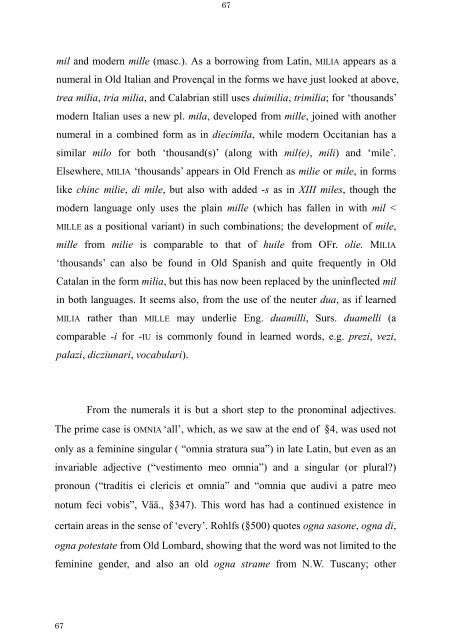The Latin Neuter Plurals in Romance - Page ON
The Latin Neuter Plurals in Romance - Page ON
The Latin Neuter Plurals in Romance - Page ON
Create successful ePaper yourself
Turn your PDF publications into a flip-book with our unique Google optimized e-Paper software.
67<br />
67<br />
mil and modern mille (masc.). As a borrow<strong>in</strong>g from <strong>Lat<strong>in</strong></strong>, MILIA appears as a<br />
numeral <strong>in</strong> Old Italian and Provençal <strong>in</strong> the forms we have just looked at above,<br />
trea milia, tria milia, and Calabrian still uses duimilia, trimilia; for ‘thousands’<br />
modern Italian uses a new pl. mila, developed from mille, jo<strong>in</strong>ed with another<br />
numeral <strong>in</strong> a comb<strong>in</strong>ed form as <strong>in</strong> diecimila, while modern Occitanian has a<br />
similar milo for both ‘thousand(s)’ (along with mil(e), mili) and ‘mile’.<br />
Elsewhere, MILIA ‘thousands’ appears <strong>in</strong> Old French as milie or mile, <strong>in</strong> forms<br />
like ch<strong>in</strong>c milie, di mile, but also with added -s as <strong>in</strong> XIII miles, though the<br />
modern language only uses the pla<strong>in</strong> mille (which has fallen <strong>in</strong> with mil <<br />
MILLE as a positional variant) <strong>in</strong> such comb<strong>in</strong>ations; the development of mile,<br />
mille from milie is comparable to that of huile from OFr. olie. MILIA<br />
‘thousands’ can also be found <strong>in</strong> Old Spanish and quite frequently <strong>in</strong> Old<br />
Catalan <strong>in</strong> the form milia, but this has now been replaced by the un<strong>in</strong>flected mil<br />
<strong>in</strong> both languages. It seems also, from the use of the neuter dua, as if learned<br />
MILIA rather than MILLE may underlie Eng. duamilli, Surs. duamelli (a<br />
comparable -i for -IU is commonly found <strong>in</strong> learned words, e.g. prezi, vezi,<br />
palazi, dicziunari, vocabulari).<br />
From the numerals it is but a short step to the pronom<strong>in</strong>al adjectives.<br />
<strong>The</strong> prime case is OMNIA ‘all’, which, as we saw at the end of §4, was used not<br />
only as a fem<strong>in</strong><strong>in</strong>e s<strong>in</strong>gular ( “omnia stratura sua”) <strong>in</strong> late <strong>Lat<strong>in</strong></strong>, but even as an<br />
<strong>in</strong>variable adjective (“vestimento meo omnia”) and a s<strong>in</strong>gular (or plural?)<br />
pronoun (“traditis ei clericis et omnia” and “omnia que audivi a patre meo<br />
notum feci vobis”, Vää., §347). This word has had a cont<strong>in</strong>ued existence <strong>in</strong><br />
certa<strong>in</strong> areas <strong>in</strong> the sense of ‘every’. Rohlfs (§500) quotes ogna sasone, ogna di,<br />
ogna potestate from Old Lombard, show<strong>in</strong>g that the word was not limited to the<br />
fem<strong>in</strong><strong>in</strong>e gender, and also an old ogna strame from N.W. Tuscany; other









